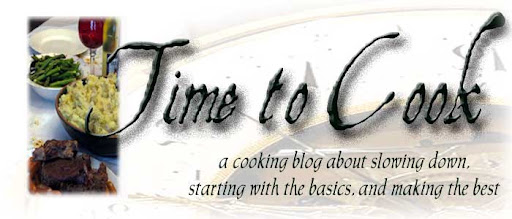There are times when chaos rules all around me and I just don't care. Today was one of those days.
We'd just returned from morning service at church and I'd decided to experiment with a new pasta and a couple of sauces. The kitchen was still in a state of limited functionality after my previous day's venture into cleaning the spice drawer and reorganizing the pantry and cupboards. Everything hadn't been put back into place yet, but I didn't care. A clean washcloth to make a clear surface on my butcher block, my food processor and a couple of pots and pans were all I needed. Everything else could tumble down around me.
And it practically did.
Kids were tracking snow through the house. Other kids were scattering toys. Other kids were playing board games on the floor of the piano room. There was delightful chaos everywhere, and I was embracing it.
After sixteen-year-old Bard finished the
Simple Hot Cocoa, I enlisted her help to make the two sauces I'd be tossing the
fresh egg noodles in. She did all of it but chop the onions. The food processor did that.

She even used the best cheese grater in the world to turn a block of Pecorino into a bowl of light, fluffy flakes. If you regularly grate hard cheeses, the
Microplane Classic Zester/Grater is the only way to go. It runs about $13.00 at the MegaKitchenType store and is totally worth it. Microplane originally began as a woodworking tool until the wife of a hardware salesman picked up a rasp to zest an orange for a cake after her other zesters just didn't cut it. She was pleasantly surprised by the results and made the Microplane Grater a regular kitchen tool. After trying rotary cheese graters and not being impressed, I'm thrilled to have added the Microplane to my list of favorite kitchen tools. I hope to soon add the
Medium Ribbon Grater for soft cheeses, butters, chocolates and apples. It may even give my Cuisinart a run for its money!
Both of the sauces were good, but the one that follows was delicious and proved the favorite of my seven testers. I'm not sure it was quite enough sauce for one pound of fresh egg noodles, and I did have to add some cream during the last stage, but it was still quite tasty. It even stopped the chaos long enough for the masses to be fed.
It takes a good bit of time to make
fresh egg pasta, so be sure to set aside an hour for a pound and another twenty minutes or more for the sauce, depending on how quickly your onions brown.
For a bit of variation, try browning a 1/2 pound of bacon, removing the bacon and leaving 1/4 cup of grease, omitting the olive oil and browning the onions in the bacon grease instead. Continue with the recipe from there.
For best results, serve the pasta in warmed bowls. It loses heat fairly quickly.
Enjoy!
xXx--=..oOo*oOo..=--xXx--=..oOo*oOo..=--xXx--=..oOo*oOo..=--xXx
After making your egg pasta into one pound of fettucine, bring four quarts of water to a boil.
Grate 1/2 cup of
Pecorino Romano very fine, maybe a bit more if you like to sprinkle the cheese on top of your pasta. Maybe even more, because you must sample it after you've grated it. It's just too light and fluffy to resist. Don't use pre-grated. It doesn't melt as nicely. It's better to just invest in a
good grater and buy fresh wedges of cheese. Often, the pregrated cheeses are of lower quality and have anti-caking agents and other preservatives added to them. If you can't find the Pecorino Romano, you can substitute a good-quality parmesan, like
Parmigiano Reggiano but you still need to fresh-grate it.
While the water is boiling and the egg pasta is resting, chop four onions very fine.
Heat 1/4 cup of extra-virgin olive oil in a saucepan that will be big enough to accomodate the noodles and the sauce. Saute the onions in the oil (or use the bacon variation suggested above) until well browned but not black.
When the onions are just about done, add two cloves of minced garlic and saute until onions are finished and garlic is lightly sauted.
Turn the heat up to medium and add 1/2 cup of white wine. Bring this to a simmer and make sure all of the onion bits are scraped off the bottom of the pan. Simmer it for about three minutes.
Add 1/4 cup of heavy cream to the pan and heat just until warm. Taste it and add salt to taste.
When your water comes to a boil, add one tablespoon of salt, then add your egg noodles. Cook them just until al dente, then quickly drain them and add them to the sauce, along with the 1/2 cup grated cheese.
Serve it warm with some more cheese on the side. A nice dish of steamed broccoli would go really well with this.
It will be worth the chaos, I assure you. Dishes, after all, can wait until tomorrow.
 "Mom, when I go to class tomorrow, I'd like to take a pot of Beef Vegetable Soup."
"Mom, when I go to class tomorrow, I'd like to take a pot of Beef Vegetable Soup."


 Last Christmas morning, my darling little ones gasped when they first caught a glimpse of the pile of loot. Sleds! Because they're so huge--and so Christmassey in and of themselves--we didn't bother to wrap them. I just leaned them picturesquely against the tree and let them take center stage, giving the first impression on the most magical morning of the year.
Last Christmas morning, my darling little ones gasped when they first caught a glimpse of the pile of loot. Sleds! Because they're so huge--and so Christmassey in and of themselves--we didn't bother to wrap them. I just leaned them picturesquely against the tree and let them take center stage, giving the first impression on the most magical morning of the year. It's the classic situation. I have a basic need. I have a few dollars. I see a killer application. I must have it. Budget? What budget?
It's the classic situation. I have a basic need. I have a few dollars. I see a killer application. I must have it. Budget? What budget?

 Let's take a little bit to veer off the main road--which has been pasta and pizza--and let's talk about dairy. I posted my recipe for granola here, so now you need something to go with it.
Let's take a little bit to veer off the main road--which has been pasta and pizza--and let's talk about dairy. I posted my recipe for granola here, so now you need something to go with it. It was a close one, but I won the bid in the last six seconds.
It was a close one, but I won the bid in the last six seconds.
